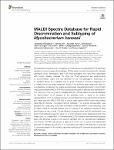MALDI Spectra Database for Rapid Discrimination and Subtyping of Mycobacterium kansasii
Murugaiyan, Jayaseelan
Lewin, Astrid
Kamal, Elisabeth
Bakuła, Zofia
Ingen, Jakko van
Ulmann, Vit
Barañano, Miren J. Unzaga
Humięcka, Joanna
Safianowska, Aleksandra
Roesler, Uwe H.
Jagielski, Tomasz
Mycobacterium kansasii is an emerging non-tuberculous mycobacterial (NTM) pathogen capable of causing severe lung disease. Of the seven currently recognized M. kansasii genotypes (I-VII), genotypes I and II are most prevalent and have been associated with human disease, whereas the other five (III-VII) genotypes are predominantly of environmental origin and are believed to be non-pathogenic. Subtyping of M. kansasii serves as a valuable tool to guide clinicians in pursuing diagnosis and to initiate the proper timely treatment. Most of the previous rapid diagnostic tests for mycobacteria employing the matrix-assisted laser desorption/ionization time-of-flight mass spectrometry (MALDI-TOF MS) technology focused on species-level identification. The purpose of this study was to establish MALDI-TOF MS reference spectra database for discrimination of M. kansasii at the genotype level. A panel of 32 strains, representatives of M. kansasii genotypes I-VI were selected, whole cell proteins extracted and measured with MALDI-TOF MS. A unique main spectra (MSP) library was created using MALDI Biotyper Compass Explorer software. The spectra reproducibility was assessed by computing composite correlation index and MSPs cross-matching. One hundred clinical M. kansasii isolates used for testing of the database resulted in 90% identification at genus-level, 7% identification at species-level and 2% identification was below the threshold of log score value 1.7, of which all were correct at genotype level. One strain could not be identified. On the other hand, 37% of strains were identified at species level, 40% at genus level and 23% was not identified with the manufacturer's database. The MALDI-TOF MS was proven a rapid and robust tool to detect and differentiate between M. kansasii genotypes. It is concluded that MALDI-TOF MS has a potential to be incorporated into the routine diagnostic workflow of M. kansasii and possibly other NTM species.
Dateien zu dieser Publikation
Keine Lizenzangabe

